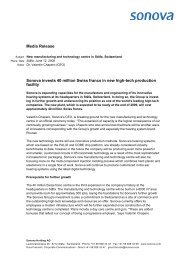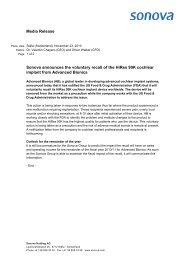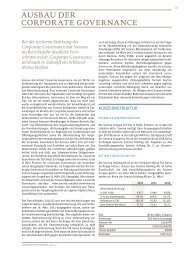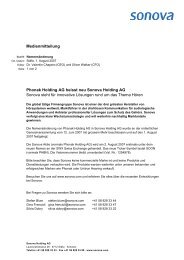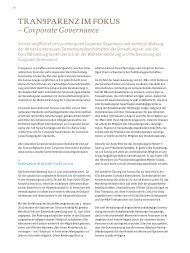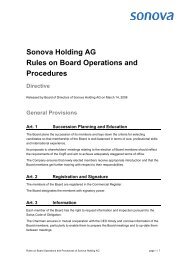Annual Report 2010/11 - Sonova
Annual Report 2010/11 - Sonova
Annual Report 2010/11 - Sonova
You also want an ePaper? Increase the reach of your titles
YUMPU automatically turns print PDFs into web optimized ePapers that Google loves.
32<br />
• Behind-The-Ear hearing instruments (BTE) (Phonak/Unitron/Sona)<br />
• FM systems (Phonak Communications)<br />
Middle ear implants<br />
(Phonak Acoustic Implants)<br />
Cochlear implants<br />
(Advanced Bionics)<br />
Custom In-The-Ear hearing instruments (ITE)<br />
(Phonak/Unitron/Sona)<br />
• Hearing protection<br />
(Phonak Communications)<br />
• Wireless communication systems<br />
(Phonak Communications)<br />
• Earphones<br />
(Phonak Audéo PFE)<br />
Harmony speech processor and HiRes<br />
90K implant<br />
Ingenia<br />
External sound<br />
processor<br />
Implant<br />
Invisible extended-wear hearing instruments (Lyric)<br />
Data and<br />
energy<br />
Sound signals<br />
Stapes<br />
prothesis<br />
Artificial<br />
incus<br />
Actuator<br />
Ingenia consists of three main components: an external<br />
sound processor, an implant assembly and a fixation<br />
system. Unlike a cochlear implant, Ingenia does not<br />
significantly enter the cochlea, so the inner-ear structure<br />
remains intact and residual hearing is preserved.<br />
Ingenia was designed with the aim of ensuring top performance<br />
even at low frequencies, enabling the user to benefit<br />
from optimal sound levels and amplification across the<br />
entire frequency spectrum. A further advantage of Ingenia<br />
is that the ear canal remains free and it is comfortable to<br />
wear. The fitting software is based on the Phonak software<br />
platform, which has been successfully used to fit millions of<br />
hearing systems.<br />
Phonak Acoustic Implants will leverage both Phonak’s<br />
and Advanced Bionics’ technical expertise and network of<br />
relationships to make Ingenia a clinical and commercial<br />
success. The company will use Advanced Bionics’ experience<br />
concerning regulatory aspects as well as its established<br />
relationships with surgeons and clinics worldwide.<br />
A cochlear implant (CI) consists of a sound processor worn<br />
externally, with a microphone that captures sound. The<br />
processor codes the audio signal into a data flow that is<br />
needed for the auditory nerve, and then transmits the<br />
data flow wirelessly to the implant below the skin. The implant<br />
receives the data flow and power from the external device.<br />
Electrodes located on a flexible wire stimulate the cochlea<br />
electrically.<br />
Active middle ear implants (AMEIs) vary both in form and<br />
functionally. In the case of Ingenia, the external sound<br />
processor captures the sound, filters and amplifies the audio<br />
signal and transmits power and the signal wirelessly<br />
through the skin. The implanted electronics then decode<br />
the signal, and energize the actuator, which in turn reconverts<br />
the electrical signal into mechanical vibrations of<br />
the artificial incus. The artificial incus transfers this vibration<br />
to the stapes prosthesis which then stimulates the oval<br />
window.




